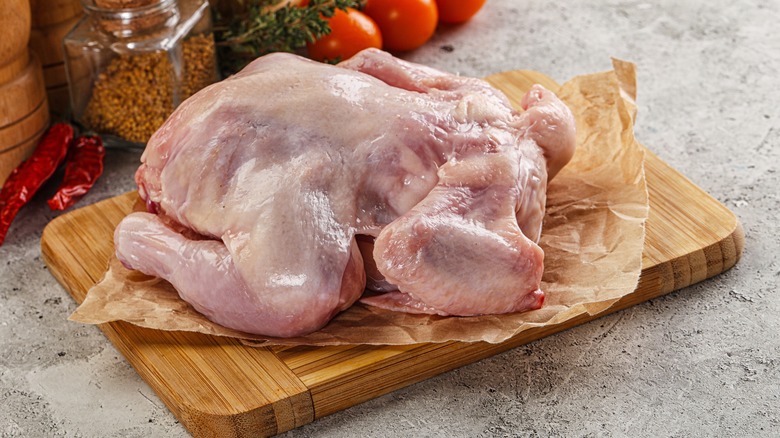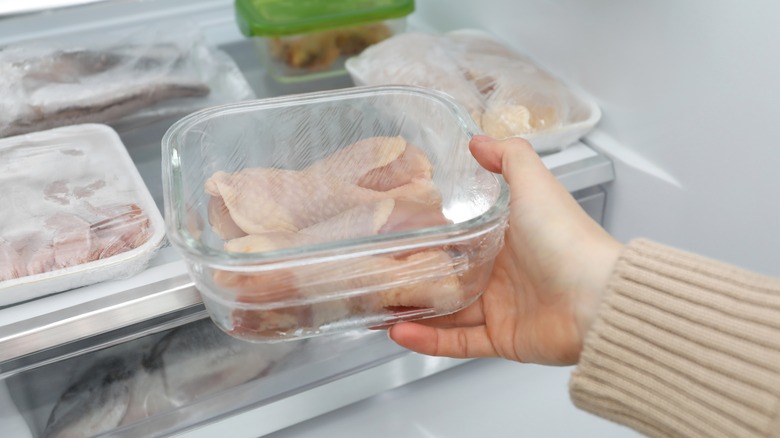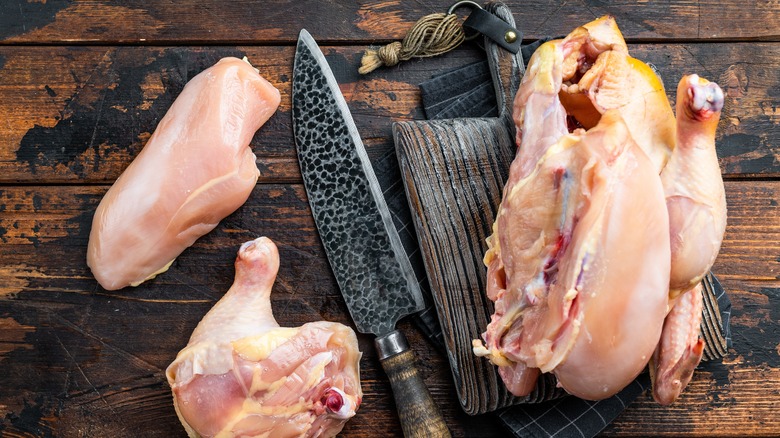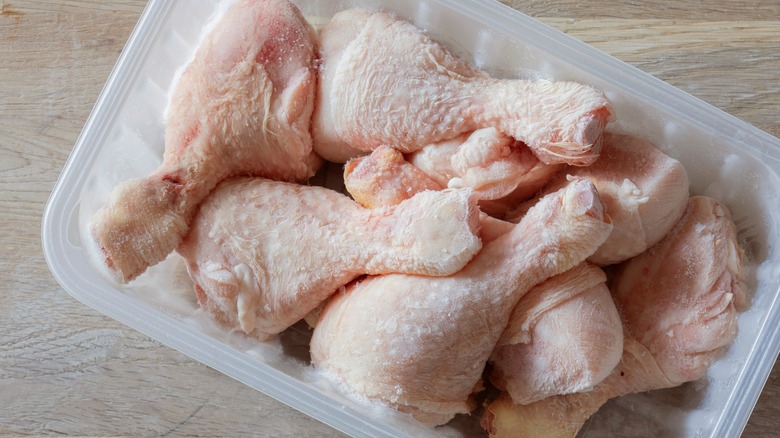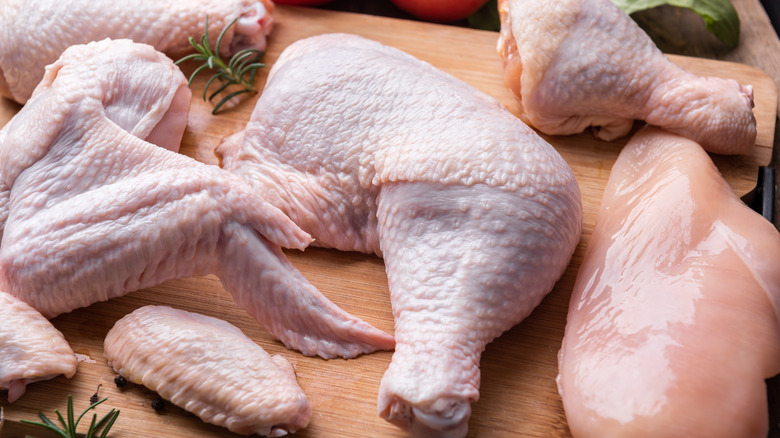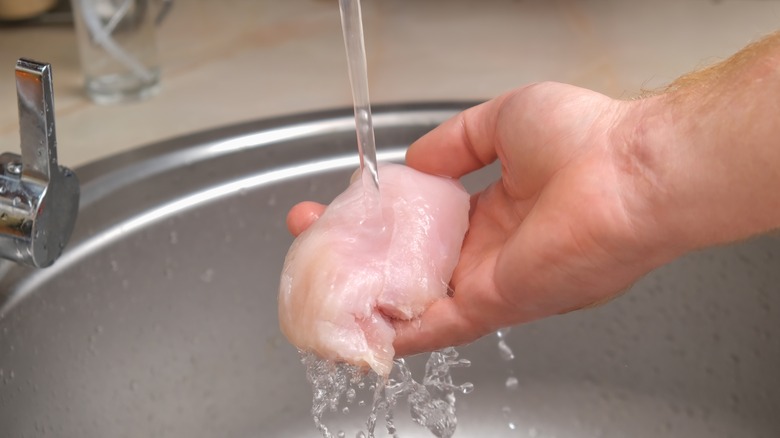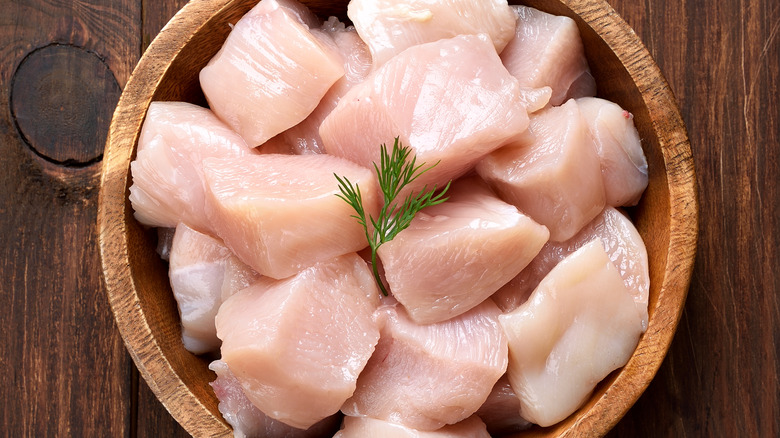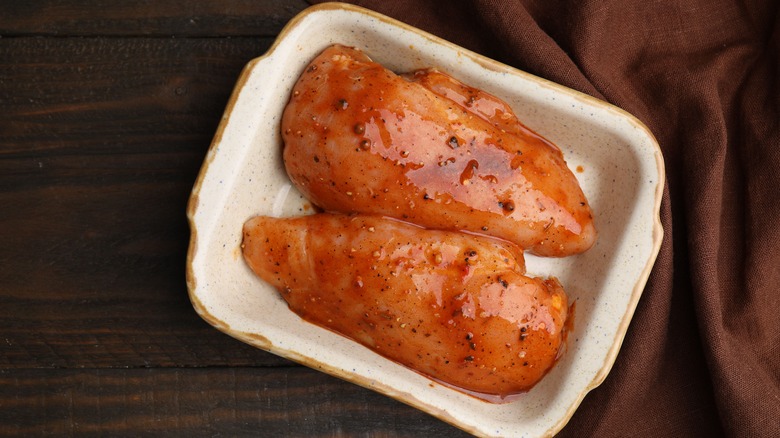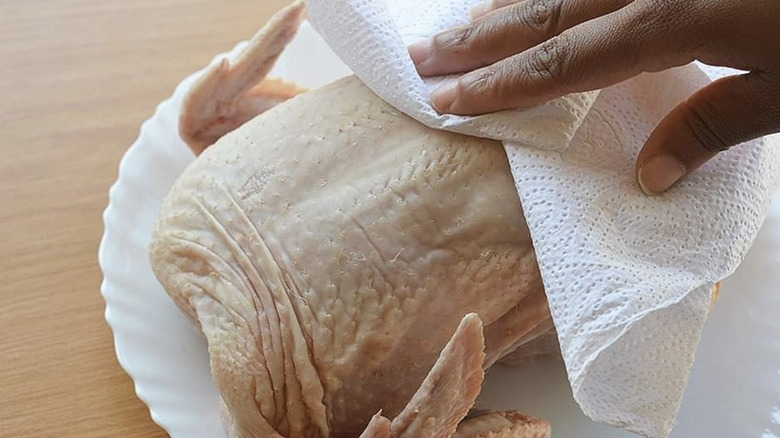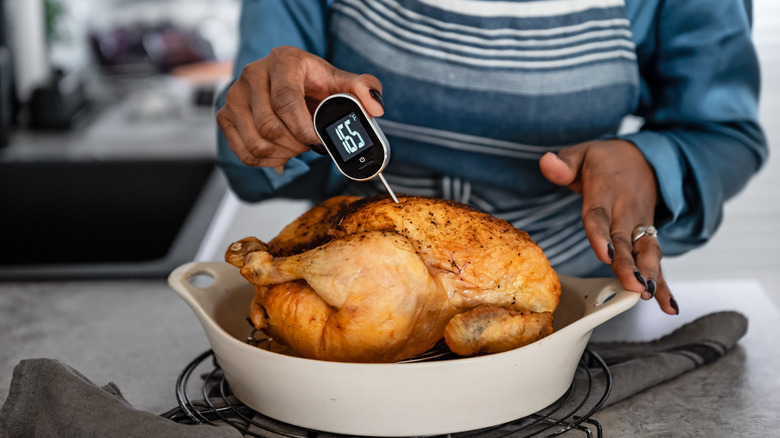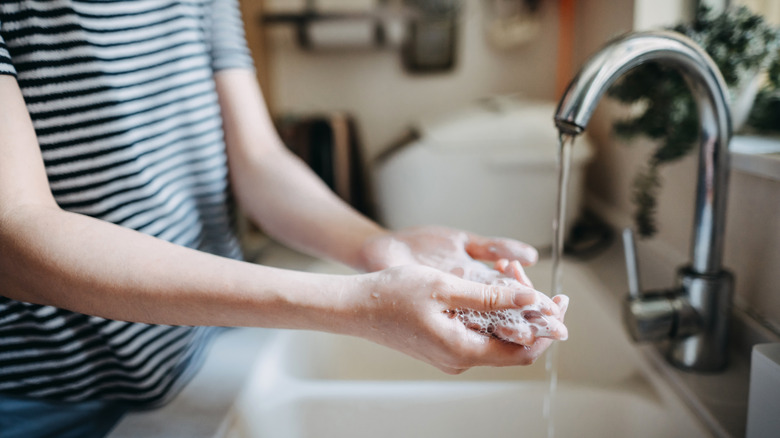12 Common Mistakes People Make With Raw Chicken
Whether it is good old-fashioned chicken wings or globally-inspired dishes like chicken teriyaki or butter chicken, poultry can be transformed into delicious culinary endeavors. Unfortunately, raw poultry can also harbor hidden dangers — it can be a breeding ground for bacteria such as salmonella and campylobacter.
Raw chicken can be purchased in different forms, including whole chickens, boneless cuts like chicken breasts, and bone-in cuts such as thighs, drumsticks, and wings. Regardless of the cut, chicken meat has to be handled, stored, and prepared with care not just to maximize its flavor but also to ensure that it is safe to eat.
Unfortunately, many of us still find ourselves making common mistakes when handling poultry. The great news is that with a little know-how, most of these are easily avoided. Ready to find out what the most common pitfalls are when dealing with raw chicken? Keep reading to find out, and also how to avoid them.
Placing raw chicken directly in the grocery store shopping cart
One of the most common reasons for chicken-related food poisoning is cross-contamination. In fact, the potential problems start at the supermarket. Most raw poultry is packaged in foam trays sealed with plastic wrap. While this packaging helps prevent leaks, it is not completely foolproof. Small tears or weak seams in the plastic can let raw chicken juices seep out of the packaging. These can easily come into contact with other grocery items in your shopping cart, potentially contaminating them with harmful bacteria. This is particularly dangerous if the other grocery items are pre-cooked or do not require cooking, such as fruit and vegetables.
To prevent cross-contamination between raw poultry and other items in your shopping trolley, always place the chicken in an extra plastic bag. This will stop any potential spills from reaching other groceries, thus keeping them safe from harmful bacteria. In addition, it is best to select chicken only after you have filled your shopping basket with other goodies, since poultry should not be left out of the refrigerator for longer than two hours and one hour in temperatures above 90 F.
Improperly storing raw chicken
Once you bring your chicken meat home, it is important to continue minimizing any chances of cross-contamination. Firstly, to remain safe to eat, raw poultry should be refrigerated at 40 F or below for a maximum of two days. Alternatively, it needs to be frozen below 0 F. As such, if you know you will nog be cooking the poultry in the near future, pop it in the freezer as soon as you can. Chicken can be stored in the freezer safely for around nine months, giving you plenty of time to turn it into a delicious meal.
It is best to store raw chicken in its original packaging, wrapping it again with a layer of plastic wrap for security. If this is not possible, store the poultry in a ziplock plastic bag or place it in a Tupperware container with a firmly closing lid. To keep the poultry fresh, place it at the back of the refrigerator, which is the coldest area. In addition, always try to place raw chicken on the bottom shelf of your fridge. This way, if any juices leak out of the packaging, they will not contaminate any other of the items in your refrigerator. Phew.
Using incorrect techniques to cut up whole raw chicken
Buying whole raw chickens can be more wallet-friendly than purchasing pre-cut poultry. It also allows you to portion the meat exactly the way you want it, and it means that you can utilize every part of the poultry. For instance, you can use the bones and offal to make chicken stock. That being said, never add chicken livers to your stock, as they can give it a bitter flavor.
Cutting up a chicken is easier with the right equipment, including a cutting board and either a sharp knife or spring-loaded poultry shears. To start, place the chicken breast side up on a cutting board before slicing the drumsticks from the breastbone. Turn the bird on its side and finish removing each leg, cutting through the joints. While the chicken is still on its side, remove the wings. Flip the chicken to its original position and separate the breast from the back by making a clean cut through the rib cage and shoulder joints. If desired, cut each breast into two portions and split the legs into drumsticks and thighs.
Defrosting chicken at room temperature
Since chicken starts to develop harmful bacteria after two hours at room temperature — or an hour at above 90 degrees Fahrenheit — defrosting it on your kitchen counter is a bad idea. Instead, the safest and easiest way to thaw frozen poultry is to leave it in the refrigerator overnight. The only downside of this thawing method is that it is relatively slow, meaning you will have to pre-plan your menu for the next day. Luckily, if you do change your mind, you can refreeze refrigerator-thawed chicken. This is because it was never exposed to the "danger zone" temperatures between 40 F and 140 F for prolonged periods of time.
If you are short on time, there are two faster ways of defrosting chicken than the refrigerator method. However, if you opt for one of these alternatives, you will have to cook the poultry immediately and will not have the option of refreezing it. One way to thaw chicken is to place it in a plastic bag and submerge it in cold water. This method should take around an hour per pound of boneless chicken. Alternatively, you can thaw poultry on the low-power defrost setting of your microwave. This is the fastest method of thawing chicken, with one pound of bird taking around 10 minutes to defrost.
Storing raw chicken for too long and failing to notice that it has gone bad
It is a common scenario — you buy raw chicken, planning to cook it within the next day or two, and promptly forget about it. The bird only resurfaces three or four days later, as you are rummaging through the refrigerator in search of a midnight snack. The big question — is the poultry still safe to eat?
The bad news is that chicken has a short shelf life, and eating it once it has gone bad can lead to serious food poisoning. Sadly, raw poultry should not be refrigerated for longer than two days. If you realize that you will not be cooking it within this time period, you can always pop the chicken in the freezer to extend its shelf life. Once frozen, raw chicken can be stored for up to nine months if it has been cut into pieces and for up to a year if it is whole.
If you leave cooking to the last minute and are not quite sure if the poultry is still safe to eat, there are a few ways to tell if chicken has gone bad. Start by inspecting the chicken visually. Any gray or green discoloration is a sure sign that your bird is destined for the trash can — that said, yellow chicken is generally safe to eat. It is also very important to smell the poultry and to check for any acidic, ammonia-like odor. Finally, raw chicken should never feel slimy or sticky to the touch. Yuck.
Washing raw chicken before cooking it
It is not surprising that some home chefs believe that rinsing chicken under running water is a good idea. After all, we have been conditioned to associate washing with cleanliness — even when it comes to food. However, in reality, rinsing chicken does more harm than good. Particularly because, these days, most poultry is already thoroughly cleaned during processing. In any case, any leftover protein or residue left on the chicken will be cooked off during preparation.
Instead of removing bacteria, the practice of rinsing poultry can actually spread it throughout your kitchen. A 2019 study conducted by the USDA found that 60% of participants who washed or rinsed their chicken ended up with bacteria in their sink. Even more concerning, 14% of these sinks remained contaminated even after they had been cleaned. However, the problem is not limited to sinks. Contaminated water droplets can end up over two and a half feet away from the sink, which means that they can easily contaminate your kitchen countertop and cooking utensils.
Failing to let raw chicken come to room temperature before cooking
There is a distinct difference between defrosting chicken on your countertop and letting it come to room temperature. While the former can leave you and your loved ones with a bad case of food poisoning, the latter is actually recommended to ensure more uniform cooking and better texture. Cold chicken that has just been taken out of the fridge tends to cook unevenly. This can leave it overcooked and dry on the outside before its interior reaches a safe temperature. Cooking poultry that has been brought to room temperature is also likely to help it retain more moisture, translating to a juicier final product.
So how do we balance food safety and uniform cooking? According to the USDA, raw chicken should not be kept unrefrigerated for longer than two hours or longer than an hour if it is sitting in temperatures above 90 F. This means that poultry can be brought to room temperature safely, provided that you heed the recommended time limits. For the best results, let the entire bird warm up on the kitchen counter for around an hour, and be sure to give smaller cuts around 30 minutes out of the refrigerator.
Failing to marinate raw chicken properly
While you can easily get away with seasoning chicken after it has been cooked, covering poultry with marinade while it is still raw can help the flavors penetrate the meat. The best marinades consist of three main types of ingredients — acid, oil, and spices. The acid, which often includes ingredients like tomatoes, vinegar, or wine, does not just imbue the poultry with flavor but also tenderizes it. The aromatics, including herbs and seasoning, give the chicken a well-rounded taste profile. Meanwhile, the oil acts both as a carrier for the flavors and locks in moisture.
Let's face it, unseasoned chicken lacks depth. On a positive note, this also makes it a perfect candidate for marinades. Nevertheless, whatever marinade you choose, it is important to remember that over-marinating can ruin your chicken. Smaller cuts absorb marinade quickly and may only need a couple of hours. Meanwhile, larger pieces of poultry may need to be left in the marinade for up to 24 hours. Whether it is a chicken breast, drumstick, or the entire chicken, letting it marinate for too long will leave you with a mushy dinner.
Raw chicken should never be marinated in a metal container, as it can interact with the acids in the mixture, leaching it into the food. To avoid this problem, stick to zip-top plastic bags or glass containers with a secure lid. Once the poultry is ready to cook, dispose of any excess marinade by throwing the plastic bag into a trash can or by carefully washing the glass container. Never reuse a marinade that has come into contact with raw chicken.
Neglecting to brine raw chicken before cooking
While the main function of marinades is to add flavor to meat, the primary purpose of brines is to make it juicier by helping it absorb and retain liquid. This can be particularly important if you want to keep lean meat, such as chicken, from drying out during the cooking process.
At its most basic, a wet brine is composed of two elements — water and salt — although other ingredients are also sometimes thrown into the mix for flavor. These can include thyme, rosemary, garlic, and honey. For best results, use 33 grams of salt for every four cups of water and stir or boil the mixture until the salt dissolves. The mixture of salt and water works by unwinding the protein strands in chicken, which then trap water inside the poultry and ensure that it remains nice and juicy. If you like your chicken skin crispy, rub it with a dry brine made with salt and your choice of seasoning.
Not patting raw chicken dry before cooking
Even if you do not rinse raw chicken — something we definitely do not recommend — it is important to pat it dry before cooking to get rid of any excess moisture. This serves two important functions. First, it minimizes the risk of splashes when the poultry comes into contact with hot oil. Second, drying chicken helps it brown and develop an appealing crust.
If the chicken is nog dry, the moisture has to evaporate before the Maillard reaction can take place. This, in turn, delays browning and can even make the poultry soggy, since wet meat steams rather than sears — you can pretty much forget about that golden-brown crust. This applies to both skin-on and skinless chicken and includes poultry that has been marinated or brined. The best way to dry poultry is by patting it with a paper towel. However, when doing this, it is also important to do all you can to prevent cross-contamination from the paper towels.
Forgetting to use a meat thermometer
There are many ways to determine whether your chicken is done — and safe — to eat, however, most of them are not foolproof. One such method is the "skewer test," which requires you to pierce the thickest part of the poultry with a skewer. If the juices run clear, the chicken is done. If they are pink, the bird needs more cooking time. Alternatively, you can also cut into the meat to look for the same signs of doneness.
While visual cues can provide guidance when cooking chicken, the only truly reliable method of checking whether your chicken is safe to eat is with a meat thermometer. To do this, insert the thermometer into the thickest part of the bird, avoiding any bones. Poultry is safe to eat once it reaches an internal temperature of 165 F.
Once removed from heat, the temperature of the meat continues to rise due to carryover heat. As such, it is best to remove whole chickens from heat once they reach between 155 F and 157 F and chicken breasts at between 162 F and 163 F. Once the protein rests, you should be sure to use the meat thermometer again to check that the poultry has reached 165 F before digging into your meal.
Failing to follow basic food safety protocols when handling raw chicken
Raw chicken can be a breeding ground for bacteria, which are only completely destroyed once the poultry reaches a temperature of 165 F. As such, it is important to handle raw chicken with a great deal of care. Aside from refraining from rinsing poultry, it is also important to sanitize all the utensils and surfaces that the meat has come in contact with to prevent cross-contamination with any ready-to-eat food items.
To play it safe, it is best to have a dedicated cutting board for raw chicken. If you use the same cutting board for raw chicken and other ingredients, such as fresh produce, always chop up the ready-to-eat recipe items before the poultry. Once you have prepared the chicken for cooking, clean all cutting boards, knives, and countertops that have come in contact with raw chicken with hot, soapy water. In addition, be sure to thoroughly wash your hands with soap for a minimum of 20 seconds each time you touch poultry.
